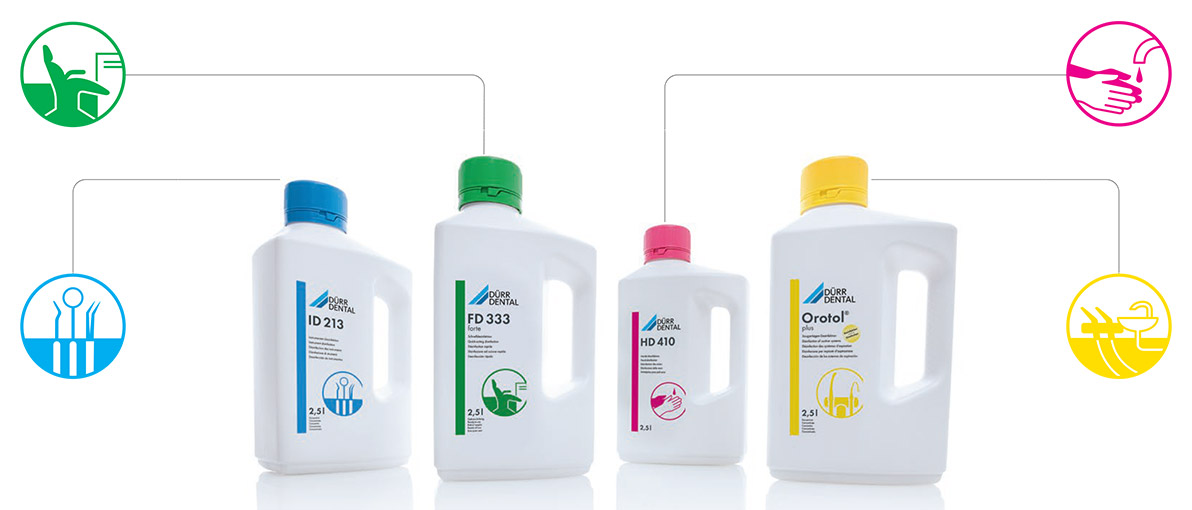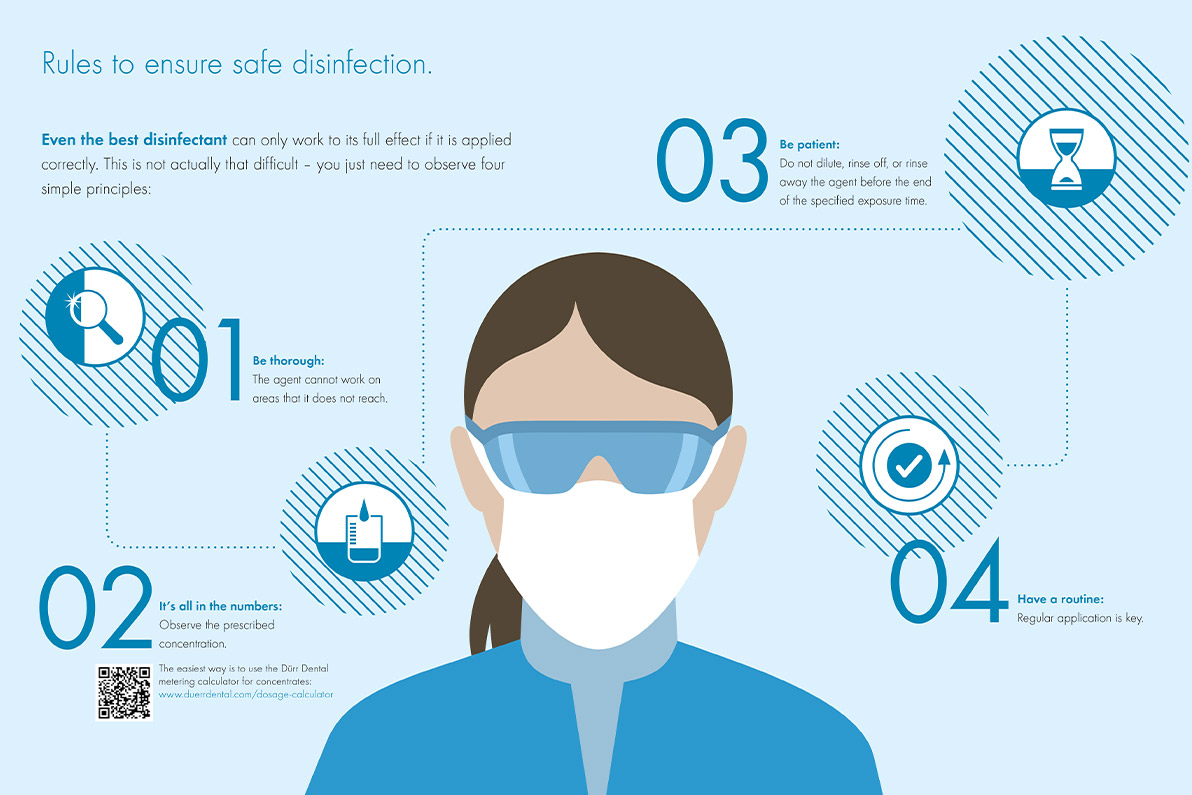Hygiene saves lives
Why assured infection protection is so important
In order to stay healthy, you first need to be aware of the main causes of illness: Bacteria, fungi, and viruses. These are invisible to the human eye. But they’re all around us, including in your dental surgery! Many bacteria, fungi, and viruses are completely harmless to humans. But some can trigger dangerous infections. When infection occurs, various germs penetrate an organism, causing illnesses. They enter via our skin, mucous membranes, respiratory system, or skin injuries as contact infections, smear infections, or droplet infections. We would like to briefly present the three most important causes of illness.
Bacteria
Bacteria are the smallest existing single-cell microorganisms. They reproduce by dividing themselves. Bacteria have different shapes – such as spherical or rod-shaped – and different properties. For example, some require oxygen to survive, and others do not. Only a small percentage of bacteria are pathogenic for humans and thus cause disease. These include Mycobacterium tuberculosis, which attacks the lungs and causes tuberculosis.
Fungi
Like bacteria fungi are a form of life. And here, too, there are harmless types. However, there are some medically relevant fungi that can cause infection diseases called mycoses. A distinction is made between dermatophytes – which trigger skin diseases, mould fungi, and candida. The latter include Candida albicans, which afflicts the skin and mucous membranes and can result in septicaemia.
Viruses
In medicine, viruses are called infectious particles. Unlike bacteria and fungi, they aren’t usually considered to be living organisms. Among other reasons, this is because they do not have their own metabolism and are therefore dependent on cells (hosts) to multiply. They are between 10 and 1,000 nanometres in size and are classified as enveloped and non-enveloped viruses. Familiar examples are flu viruses, hepatitis, HIV, and noroviruses.
A critical environment.
Dental surgeries are places with an increased risk of infection. Due to regular contact with blood, saliva, and secretions, germs can reach the human organism if protection measures are insufficient. There are various means of transmission: Via droplets, smear infection, or contact infection. This can happen directly from one person to another or indirectly via contaminated instruments, surfaces, and devices.
A focus on means of transmission.
During everyday surgery life, there is an increased risk of infection. We now know exactly where there is an increased infection risk. Here, you can find out details about what happens during transmission by the various different means.
Droplet infections – When droplets form when people sneeze, cough, or just speak, pathogens such as flu viruses can be transmitted in the air. If these pathogens penetrate the mucous membranes and multiply there, infection can occur.
Hands – The hands are the most frequent means of the transmission of pathogens, since they come into contact with patients, instruments, surfaces, and devices. Everyday actions such as shaking hands can result in infection
Spray mist cloud – The spray mist cloud is a mixture of saliva, blood, secretions, tooth substances, dentifrice, and other particles. It is created in dental surgeries when patients are treated using powerful rotating drills in conjunction with cooling water. As a result, pathogens enter the environment during dental treatment. This often contaminates the entire room. Pathogens can enter our bodies via our skin, mucous membranes, respiratory system, or open wounds.
Surfaces – During treatment, surfaces are contaminated through contact with people, instruments, or the spray mist cloud. Unprotected contact with these contaminated surfaces can therefore result in infection.
Instruments – Instruments come into contact with saliva and blood during treatment and are therefore contaminated with pathogens. For this reason, unprotected contact with used instruments that have not been disinfected or sterilized poses a huge risk of infection.
Detailed prevention measures.
Prevention is the first step to efficiently reducing the risk of infection in everyday surgery life. Here, we show you which measures are particularly efficient and can quickly become part of your everyday routine.
Surgery team
▪ Careful hand cleaning and disinfection is absolutely vital. This is because your hands are the most frequent means of transmission of pathogens.
▪ Protective clothing, gloves, goggles, and mouth-nose guards reduce the risk of droplet infection and direct/indirect contact infection.
▪ Vaccinations effectively minimize the risk of specific infections.
▪ The training of the surgery team with regard to the importance and correct implementation of hygiene measures is an important part of surgery hygiene.
Patient
▪ The taking of an anamnesis – a detailed history of the patient’s state of health – can detect possible infection risks arising from the patient and allow appropriate measures to be implemented.
▪ Mucous membrane antiseptic rinses reduce the pathogens in the patient’s saliva, on the mucous membranes, and in the spray mist cloud significantly.
Surgery
▪ The correct repeated preparation of used instruments – by means of disinfection, cleaning, packaging, steam sterilization and storage – considerably reduces the risk of infection.
▪ The regular maintenance of devices in accordance with the instructions of the manufacturer and the replacement of damaged parts enable safe treatment for both the surgery team and the patient.
▪ The thorough but gentle cleaning and disinfection of surfaces eliminates risks and contributes to preserving the value of the surgery’s equipment at the same time.
▪ The regular cleaning and disinfection of the suction systems protects against infection and ensures a long life as well as the preservation of equipment value.
 Effective elimination of contamination.
Effective elimination of contamination.
It is simply impossible to completely prevent contamination during everyday surgery life. This means that thorough cleaning is vital yet insufficient. Cleaning eliminates soiling but cannot kill off or deactivate pathogens. This requires a disinfectant, which – by definition – eliminates 99.999 % of pathogens. Mostly, chemical substances that destroy the structure of germs are used, thus killing them off or deactivating them.
Fields of action – Because there are different pathogens, disinfectants must have specific fields of action to be able to work reliably: Bactericides kill bacteria, tuberculocides kill tuberculosis pathogens, and fungicides kill fungi. Because viruses are not living organisms, we speak about rendering them inactive rather than killing them. This means that virucidal disinfectants render all viruses inactive. A good disinfectant covers all of these fields of action.
Fields of use – The effectiveness of disinfection depends on the relevant field of use. This is because there is no disinfectant that can reliably and gently disinfect hands, surfaces, instruments, and devices at the same time. This means that effective hygiene at your dental surgery is only possible if you use an optimum combination of disinfectants to cover all areas and use them in accordance with the instructions of their manufacturers.
It’s best to keep everyone healthy.
When it comes to infection protection, disinfection, and cleaning, nothing should be left to chance. For this reason, back in 1965 Dürr Dental developed Orotol – the first disinfectant for suction systems. This marked the start of the continual development of our competence in the field of hygiene. Today, dental surgeries all around the world place their trust in the comprehensive Dürr System Hygiene.
For more than 30 years, the logical four-colour coding system has been making dental surgeries a safer place to be. Its reliable efficacy has been tested, it is easy to use, and the products are perfectly tailored to compliment each other. In short, this is the best system for hygiene at your surgery – Made in Germany
Find out more from Medi-Dent
Located in Melbourne, we are major partners of 3M and Kavo Kerr; exclusive distributors of Medesy and PDT instruments; and authorised sales and service agents for some of the world’s leading equipment brands including A-dec, Acteon, Cattani, Durr, EMS, NSK, Vatech and W&H to name a few.
If you would like to know more about Medi-Dent Products and Services please get in touch with us, our experienced sales and service team are ready to assist
Contact us via email [email protected]
Contact us via phone 1300 886 674
And visit us online www.medident.com.au
Where: 39–41 Lakewood Boulevard, Braeside, Victoria, 3195 (Mon–Fri 8:30am – 5:30pm) Showroom visits are by appointment only, please contact us to schedule a meeting.[/vc_column_text][/vc_column][/vc_row]


 Effective elimination of contamination.
Effective elimination of contamination.